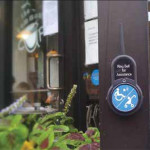
What is “accessibility,” exactly? Far too often, businesses either confuse the need for accessibility with ADA compliance or lump accessibility into a “social services” category, when in fact creating accessibility is so much more complex.
According to the U.S. Small Business Administration, the number of small businesses in America has increased by 42% over the course of the last decade. What’s fueling this growth? Initially, some credit can be thrown to the local food movement. Foodies, and the restaurants serving them, raised awareness around the benefits of eating local. And pushing this idea further, both neighborhood alliances as well as behemoth corporations like American Express (#SmallBizSaturday) inspired communities to not just eat local, but to shop local as well. Good news for you as a small retailer – you’re in the right place at the right time! Whether these customers are walking, biking, or rolling in a wheelchair by your storefront, they are shopping local. They’re not in a car heading to Target.
Making sure your storefront is accessible to everyone takes advantage of this “shop local” dynamic and stimulates both your business as well as your community’s economic viability. In fact, according to the Andersonville Study of Retail Economics, local business generates 70% more local economic activity per square foot than big box retail. That’s a sizeable return. Furthermore, an accessible shopping environment contributes to your neighborhood’s livability, in turn attracting new customers from nearby locales and encouraging networked commercial area activity.
To better understand this opportunity today, take a look at five statistics regarding one segment of this “shop local” population, the disability community:
- The U.S. Census Bureau reports there are an estimated 3.6 million wheelchair users in the United States. This number is increasing every year due to the aging baby boomer generation. In fact, at present, one in five baby boomers face a mobility challenge, and these baby boomers have the largest percentage of discretionary income at their disposal.
- According to research by the city of Cambridge, Massachusetts, people with short or long term disabilities and older individuals who may have difficulty with architectural barriers wield $175 billion in discretionary spending power. This power is more than the African‐American, Latino, and LGBTQ markets combined. In fact, this figure suggests the disability community’s consumer spending power is double the spending power of teens and more than 17 times the spending power of tweens – the two most desirable demographic groups.
- The City of Cambridge research also indicates 75% of people with disabilities eat at restaurants at least once a week.
- In a 2013 report on “The Global Economics of Disability” issued by Fifth Quadrant Analytics, figures from the U.S. Bureau of Labor Statistics indicate family, friends, and those with “an innate reason to understand disability and its impact” represent another $6.9 trillion of disposable income globally.
- 5th Quadrant Analytics also cites data indicating the disability consumer market is so substantial, 25% of the S&P 500 has publicly expressed their interest in securing a “first mover advantage” in their respective marketplace. In other words, these organizations find the disability market so attractive, they want to establish market share before their competitors.
So, what is the key to driving “shop local” behavior? The answer is multifaceted, but it is critical that despite the disability-specific statistics highlighted above, small business owners recognize accessibility is a winning business strategy that keeps all customers with an inclination to “shop local” coming back. Innovations increasing storefront access for those with a disability are actually applicable to all, and thereby increase ROI on a much broader scale. For example, an accessible environment is more attractive to a mother with a stroller or a buyer shouldering multiple packages, not just to the individual in a wheelchair. And mastering a people-based business is what enables customer loyalty and repeat visits.
Read more about Inclusion Solutions’ retail products and solutions.